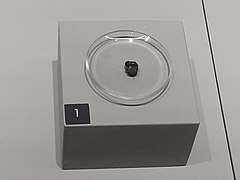Alais meteorite
Alais or Allais is the first carbonaceous chondrite meteorite identified. It fell near Alès in 1806 in multiple fragments which together weighed 6 kg (13 lb 4 oz), although only 0.26 kg (9.2 oz) remains. The meteorite contains a number of elements in similar proportions to the solar system in its primordial state. It also contains organic compounds and water. It has proved to be one of the most important meteorites discovered in France.
| Alais | |
|---|---|
| Type | Chondrite |
| Class | Carbonaceous chondrite |
| Group | CI1 |
| Country | France |
| Region | Occitanie |
| Coordinates | 44°7′N 4°5′E[1] |
| Observed fall | Yes |
| Fall date | 15 March 1806 |
| TKW | 6 kg (13 lb 4 oz) |
 A fragment of the meteorite on display in 2018 | |
History
At 17:00 on 15 March 1806, two detonations were heard near Alès in Gard, France.[2] Shortly afterwards, two soft black stones were discovered in the villages of Saint-Étienne-de-l'Olm and Castelnau-Valence, weighing 4 kg (8 lb 13 oz) and 2 kg (4 lb 7 oz) respectively. The fragments were collected by people who observed the impact and given to two scientists that lived locally.[1] The meteorite was analysed by Louis Jacques Thénard, who published a study in 1807, showing that it had a high carbon content.[2] It was initially doubted that the fragments were of non-terrestrial origins as their attributes were markedly different to existing meteorites.[3] However, it was increasingly realised that this was a new, albeit rare, type of meteorite.[4]
Description
Overview
The Alais meteorite is one of the most important meteorites in France.[5] It is black with loose friable textures with a low density of less than 1.7 g/cm3 (0.061 lb/cu in).[2] Originally consisting of fragments that together weighed 6 kg (13 lb 4 oz), it has been subject to substantial scientific examination and currently only 260 g (9.2 oz) remains.[6] A fragment, weighing 39.3 g (1.39 oz) is held by the National Museum of Natural History, France.[7]
Composition and classification
The meteorite is one of five known meteorites belonging to the CI chondrite group.[3] This group is remarkable for having an elemental distribution that has the strongest similarity to that of the solar nebula. Except for certain volatile elements, like carbon, hydrogen, oxygen, nitrogen and the noble gases, which are not present in the meteorite, the ratios of the elements are very similar. The meteorite contains cubanite, dolomite, fosterite, pyrrhotite and zircon amongst other minerals.[8]
Origin of life controversy
The meteorite has been at the centre of controversial claims about an extraterrestrial origin of life since the discovery of organic matter on the meteorite by Jöns Jacob Berzelius.[9] Organic compounds, amino acids and water have been found in the meteorite. However, studies differentiate between organic and biological matter, the latter not being present.[4]
Alternative names
The meteorite is also known as Valence.[1]
See also
References
Citations
- Meteoritical Bulletin Database: Alais
- Marvin 2006, p. 53.
- Mason 1963, p. 621.
- Marvin 2006, p. 54.
- McCall, Bowden & Howarth 2006, p. 5.
- Mason 1963, p. 622.
- Caillet Comorowski 2006, p. 192.
- Kerridge, Macdougall & Marti 1979, p. 360.
- Chyba 1990, p. 113.
Bibliography
- {{cite journal | last=Faidit | first= Jean-Michel. | title=Bicentenaire de la météorite d'Alais | journal=L'Astronomie | volume=120 | year=2006 | page=162-165}
- Caillet Comorowski, C.L.V. (2006). "The meteorite collection of the National Museum of Natural History in Paris, France". In McCall, G.J.H.; et al. (eds.). The History of Meteoritics and Key Meteorite Collections: Fireballs, Falls and Finds. London: The Geological Society. pp. 163–204. ISBN 978-1-86239-194-9.
- Chyba, Christopher F. (1990). "Extraterrestrial amino acids and terrestrial life". Nature. 348 (6297): 113–114. Bibcode:1990Natur.348..113C. doi:10.1038/348113a0.
- McCall, G.J.H.; et al. (2006). "The history of meteoritics – an overview". In McCall, G.J.H.; et al. (eds.). The History of Meteoritics and Key Meteorite Collections: Fireballs, Falls and Finds. London: The Geological Society. pp. 1–13. ISBN 978-1-86239-194-9.
- Kerridge, John F.; Macdougall, J. Douglas; Marti, K. (1979). "Clues to the origin of sulfide minerals in CI chondrites". Earth and Planetary Science Letters. 43 (3): 359–367. Bibcode:1979E&PSL..43..359K. doi:10.1016/0012-821X(79)90091-8.
- Marvin, Ursula B. (2006). "Meteorites in History: An Overview from the Renaissance to the 20th Century". In McCall, G.J.H.; et al. (eds.). The History of Meteoritics and Key Meteorite Collections: Fireballs, Falls and Finds. London: The Geological Society. pp. 15–72. ISBN 978-1-86239-194-9.
- Mason, Brian (1963). "The Carbonaceous Chondrites". Space Science Reviews. 1 (4): 621–646. Bibcode:1963SSRv....1..621M. doi:10.1007/BF00212446.
- Mason, Brian (1967). "Meteorites". American Scientist. 55 (4): 429–455.